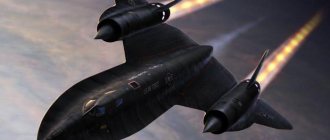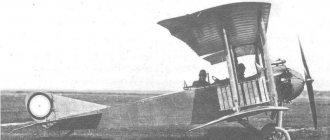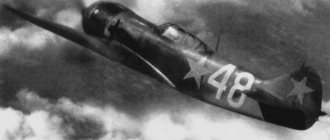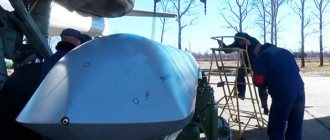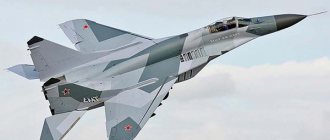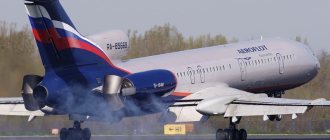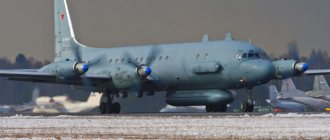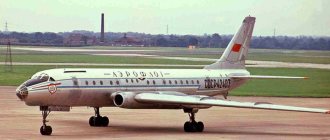Tupolev's design bureau held one of the leading positions in the USSR in the field of creating passenger airliners. Development of the Tu-204 airliner began in the early 80s, and the first aircraft took off shortly before the collapse of the Soviet Union. Because of this, the aircraft was unable to repeat the success of its predecessor, the medium-haul airliner Tu-154, built in a circulation of more than 1,000 copies. When creating the machine, computer design calculations using the finite element method were used. The system became the first in the country and subsequently found wide application at a number of aircraft manufacturing and aerospace enterprises.
The birth of the Tu-214 aircraft became possible thanks to an attempt to expand the production of the 204th aircraft. The aircraft assembled at the aircraft plant in Kazan began to be designated as model 214.
Development and concept
Work on creating a promising airliner designed to replace the Tu-154 began already in 1973, i.e. just five years after the start of mass production.
At the initial stage, the designers explored the possibility of creating an improved model based on the fuselage and airframe of the Model 154.
At the same time, a project for a new vehicle with three engines (two under the wing and one in the tail of the fuselage) appeared.
A prototype of a similar machine, designed to install D-90 engines, was built in 1982. But the project did not receive further development; the designers switched to creating an aircraft with two engines installed under the wing.
The development of aviation technology in the USSR was started by a resolution of the Council of Ministers. In 1983, a document was published that required the creation of airliners with two and four engines of the same model. At the same time, a competition was announced for the development of the engine. Tupolev Design Bureau continued work on the project, which received the Tu-204 index; in 1985, L.A. was appointed the lead designer of the project. Lanovsky.
When creating a new aircraft, a universal system for calculating parameters created at the Tupolev Design Bureau was used.
The system used a computer complex and made it possible to create wing and fuselage profiles of high aerodynamic quality. Hybrid materials and carbon fiber were widely used in the design of the future Tu-214. The total weight of such materials in the structure is about 14%. The aircraft pioneered new assembly techniques and the use of titanium fasteners.
The first flight of the Tu-204 took place in 1989. The test flights resulted in numerous improvements to the design and control systems. Due to the cessation of project funding, the tests were delayed, and the aircraft received a certification document only at the very end of 1994.
oEPBSHI SHYGELOKP YAYULNKERYU YAOEZHHYUKEMNTSN MYUGMYUVEMH (KETSYUKEMNI YUBKHYUPYUGBEDYKH) RS-214nm"nRYPSHRNE MEAN" Kommersant "BETSIU". 1 KHChM 2011 TSNDYU B yYUGYUMH YAYULNK╦R YANBEPHK OEPBSHI HYAOSHRYUREKEMSHI ONK╦R. KERVHYH-HYAOSHRYUREKH YNLOYUMHH "rSONKEB" BSHONKMHKH 24 HYAOSHRYUREKEMSHU ONKERYU KH DUKH BSHYANISCH NZHEMYS. REOOPE MYUVYU ONDTSNRNBYU KYUIMEPYY YAEPRHTHYUZHNMMSHL HYAOSHRYUMKHL, YNRNPSHE YARYUPRSCHR B MUVYUKE 2012 TSNDYU, OEPEDYUER grunting-ruyaya.
RS-214nm NANPSDNBYUM YANBPELEMMSHL YNLOKEYANL ayum (ANPRNBSHL YNLOKEYANL YUBKHYUZHNMMNTSN MYAKCHDEMHYU), ONGBNKQCHYHL NYASYYARBKRE YNMRPNKE YANAKCHDEMKH DNTsNBNPNB ON NTSPYUMHVEMKHH BNNPSPHEMKHI. b YANYARYUB ayum BUNDYR YUSCHPNTNRNYUOOYUPYURSH, rb- X hy-YYULEPSH, PUDHNKNYURNP ANINBNTSN NAGNPYU I YAHMREGKHPNBUMMNI YOOEPRSPNI. YANTSKYUYAMN DNTSNBNPEMMNYARKH PUGPEEEMKHE YUSCHPNTNRNYUOOYUPYURYU H rb- YYULEPSH YANYARYUBKER 30 YAYUMRKHLERPNB, DK PUDHNKNYURNPYU ANINBNTSN NAGNPYU - RPH LERPYU, DK hy-Y YULEPSH - 50 YAL.
yYUY PYYAYAYYUGYUKH B DHPEYZHHH YNLOYUMHH, MNBHMYU NANPSDNBYUMYU YANBPELEMMSHLH OPKHANPYULH DK YUSCHPNTNRNYAZELYH X DPSTSHLH SHTTEYRHBMSHLH YAPEDYARBYULH MYUACCHDEMH, OPHVEL BOEPBSHE ME RNKAIN NREVEYARBEMMSHHLH. PYUME NYAMYUYURE ANPRNBSHE YNLOKEYYASH MYAKCHDEMHJ KHLONPRMNI REUMKHYNI PNYAYAKH ME HLEKYU OPYUBYU.
KYUIMEP OPEDMYUGMYUVEM DK KHMIAOEYZHNMMSHU ONKERNB MYUD REPPHRNPKHLH TSNYASDYUPYARB √ SVIYARMKHYNB DNTsNBNPYU ON "nRYPSHRNLS MEAS". nM ASDER YAKEDHRE I BNGDSUYU GYU REL, YUY B DPSTSKHU YARPYUMYU BSHONKMCHRYA OSMYRSH BYUFMEIKHU LEFDSMYUPNDMSHU YANTSKYUYEMKHI, B RNL VHYAKE KH B NAKYUYARKH BNNPSFEMKHI.
rs-214nm OPHGBYUM GYULEMHRE SYARYUPEBKHE rs-154 X yuM-30. mu YARYUOEKU yuon KHLEMKH tsNPASMNBU BEDERYA JANPYU EYE NDMNTsN YUMYUKNTSKHVMNTsN KERYUREKEMNTsN YOOYUPYURYU.
DNTsNBNP ON "nRYPSHRNL MEAE" ASHK OPKHMIR 27 TsNYASDYUPYARBYULH √ SVIYARMHYULH naye B 1992 TsNDS. YANTSKYUEMHE NRYPSHKN BNGDSMNE OPNYARPYUMYARBN MYUD MHLH DK YNMRPNK B ZHEKU ONDDEPFYUMH LHPYU. mSHME B LEFDSMYUPNDMNL DNTsNBNPE SVIYARBSCHR 34 YARPIUMSH.
boepbshe rS-214nm ASHK OPNDELMYARPHPNBYUM NAYYYARBEMMNYARH MU LEFDSMYUPNDMNL YUBHYUYUKNME lyuya-2011. YaYULN ONEBKEMKHE B PNYAYAHH YAYULNKERYU RS-214nm ONKSVHKN ANKENNI PEGNMYUMYA. b UNDE YUBKHYUNNS YYULNKER ONYAERHKH X DUKH ELS BSHYANYSCH NZHEMYS OPEDIARYUBHREKH hRYUKHKH, mNPBETSKHKH, yYUMYUDSH, yayu.
NYAMNBMSHL SHYYAOXYURYUMRNL RS-214nm YARYUMER lHMNANPNMSH pt.
cru:
| lNDHTHYUZHH | RS-214nm |
| pYUGLUU YPSHKYU, L | 42.00 |
| dKKHMYU YAYULNKERYU,L | 46.20 |
| bSHYANRYU YAYULNKERYU,L | 13.90 |
| OKNYYUDE YPSHKYU, L2 | 182.40 |
| I love it, JC | |
| OSYARNTSN YYULNKERYU | 59000 |
| LYUYAHLYUKEMYU BGKERMYU | 110750 |
| RHO DBKHTSUREK | 2 rbpd oya-90yu |
| rtsyu, ytsya | 2 U 16000 |
| LYUYAKHLYUKEMYU YAYNPNYARE, YL/V | |
| yPEIYEPYAYU YAYNPNYARE, YL/V | 850 |
| oPUYRHVEYAYU DUKEMNYARE, YL | 6500 |
| oPUYIRKHVEYAYKHI ONRNNKNY, L | 12000 |
| ShYKHOYUF, VEK |
| bottom. KhMTNPLYUZHKH: |
| tNRNCPYUTHH: | OEPBSHI SHYGELOKP RS-214nm (c) nyun rSONKEB |
| RS-214nm (c) bHRUKHI hPRUEEB (el-moino) | |
| RS-214nm MU lyuyaE | |
| RS-214nm MU lyuyaE | |
| RS-214nm MU lyuyaE |
bYUPHYUMRSH NYPYYAYH:
| RS-214nm |
| YaOHYANY HYARNVMKHYNB: |
| nyun rSONKEB. RS-214nm Aviaport.ru. YaYULNKER RS-214nm YANBEPHK OEPBSHI ONKER |
sTSNKNY MEAYU. 2013
Design
The Tu-214 airliner is a monoplane with a high aspect ratio swept wing located in the middle of the fuselage. The design of the machine allows for safe gliding and landing with a failed power plant.
The passenger cabin of the standard version of the Tu-214 with a capacity of 164 passengers with a standard tourist seating arrangement has the following parameters:
- pitch 960 mm for 1st class cabin;
- pitch 810 mm for economy class.
The layout of the cabin can be changed, which provides a capacity of up to 210 people. Baggage and cargo are placed in 8 standard containers of type LD3-46. Three of them are installed in the front cargo compartment, the rest in the rear. There is also an additional cargo compartment designed for 2000 kg. In total, the Tu-214 is capable of transporting up to 12.4 tons of luggage.
Engines
Tu-214 aircraft are equipped with PS-90A turbofan engines, created at the Aviadvigatel Design Bureau and manufactured by the Perm Engine Plant. The engines are located under the aircraft's wing in a closed nacelle mounted on a pylon.
| Engine weight, kg | 4160 |
| Length, mm | 4964 |
| Diameter, mm | 1900 |
| Take-off thrust, kgf | 16000 |
Chassis
The Tu-214 aircraft uses a tricycle landing gear with a nose-mounted steering wheel. The main struts fold into niches located in the fuselage of the aircraft. When cleaning, the nose strut moves against the incoming air flow.
After the racks are released, the niches are closed with sashes.
The landing gear control is connected to the aircraft's second hydraulic circuit, using the third as a spare. Emergency release of the main struts is carried out under its own weight, the bow support comes out only from hydraulics.
In this case, the doors do not close. The front strut is rotated by rack-and-pinion hydraulic mechanisms using pedals (during takeoff and landing) or by handles (during taxiing).
The brakes have a remote electro-hydraulic drive from the main and backup systems. Disc brakes are made of low-carbon material and are installed on all wheels. There is a skid braking protection system. The brakes have an emergency stop and automatic braking mode.
Control system
The Tu-214 uses a fly-by-wire control system.
To deflect the surfaces of the control and elevator rudders, as well as the brake flaps and ailerons, irreversible hydraulic drives are used.
Power supply system
There are several DC and AC power supply systems on board the aircraft:
- main, three-phase current 115/200V at a frequency of 400 Hz;
- additional, DC, 27V.
Voltage sources are generator sets located on the engines and batteries. On the ground, electricity is generated by a generator of an auxiliary gas turbine unit located in the rear fuselage. Generator models vary from aircraft to aircraft.
Fuel system
The Tu-214 uses separate fuel supply for each engine. The fuel supply is located in six wing caissons and one keel tank.
The total capacity of the tanks is 35,700 kg. Refueling is carried out centrally.
The engines are powered from separate consumable tanks equipped with an emergency residue indicator. The alarm is activated when there is 1300 kg of fuel remaining in each container.
A special feature of the system is the automatic transfer of fuel from tanks installed on the root of the wing to a tank located on the keel. Fuel is pumped automatically to ensure centering of the vehicle in flight.
Hydraulic system
The aircraft's hydraulics include three independent systems powered by pumping units located on the engines. The first and third systems have one pump each, the second is connected to two pumps.
In the event of engine failure, each system is capable of operating from an autonomous electric pump, ensuring the operation of control systems. The first system uses an additional pump driven by an air turbine impeller. The pump is used in case of emergency and engine failure.
Anti-icing system
The Tu-214 aircraft is equipped with a system to protect against the formation of ice build-up on the air supply channels to the engines, sensors on the wings and windshields of the cockpit. The design of the tail actively prevents the formation of ice, so anti-icing agents are not provided for them.
Air conditioning system
For air conditioning of the cabin and crew cabins, air is taken from the engine compressors. When parking on the ground, the use of a mobile air conditioning unit is allowed.
The air conditioning system operates in automatic mode, maintaining the set temperature according to data received from several sensors.
There were different cases
In real life, sometimes situations arise that neither an educational nor a gaming simulator can simulate. The Tu-154 has been through various alterations over the years of operation. This plane had a chance to collide with an American flying tanker and land with a damaged plane (Manas air base, 2006). In another case, during landing, noticing snowplows, the pilot managed to lift the car and, at an angle, on one landing gear, avoid mortal danger. The episode with the landing of an airliner with a completely de-energized on-board system on an abandoned airfield became very famous (Izhma, 2010). True, even then there was a human factor. The flight engineer, not noticing that one of the four batteries had failed, connected it to the common circuit, causing a short circuit. It was possible to save the plane and passengers thanks to the highest qualifications, courage and resourcefulness of the Tu-154 pilots. The landing was rough, but there were no casualties. Unfortunately, not all incidents ended so well.
Production and operation
The production of the first Tu-204 dates back to 1989. The peak of production was reached in 2008, when 10 cars left the factory floors. The total number of model 204/214 aircraft built is 85 units.
The first Tu-214 arrived in the spring of 2001.
The vehicle received tail number 64502. The vehicle was handed over to the customer in a ceremonial atmosphere with the participation of high-ranking officials.
Over the next three years, two more vehicles were delivered (sides 64503 and 64507). In total, by the end of 2004, seven airliners were assembled. used cars for flights to Japan, China, South Korea.
The second operator was , which received three vehicles in 2004. The aircraft were used for flights to India, Mongolia, Israel, as well as within the country. Several machines were also used by Transaero.
High tempo
In 1965, design work began, led by S. M. Eger, then A. S. Shengardt and the general designer A. A. Tupolev himself became involved. In less than three years, efforts culminated in the construction of six prototypes, which were soon tested. In October 1968, the first flight took place (test pilot Yu. V. Sukhov). The following year, the Tu-154 went into production at plant No. 18 (Kuibyshev). At the same time, the “Russian Boeing” was shown at the Le Bourget aerospace show. In parallel with the construction of the first copies, further tests continued, aimed at identifying shortcomings, which lasted five years. Such a high rate of design and launch into production demonstrated to the world the enormous capabilities of the Soviet aviation industry and engineering school.
Flight performance
The advantage of the Tu-214 is its long flight range, which is achieved due to the increased fuel supply located in the long wings.
| Parameter | Tu-214 | Airbus A-321 | Boeing 737-900 |
| Length, mm | 46140 | 44510 | 42100 |
| Wingspan, mm | 41800 | 34100 | 35700 |
| Height, mm | 13880 | 11760 | 12500 |
| Speed, km/h | 850 | 840 | 823 |
| Capacity, persons | 210 | 220 | 215 |
| Range, km | 6890 | 5950 | 6045 |
| Ceiling, m | 12100 | 12000 | 12500 |
There are few of them left
Today, this machine, so famous and recognizable in the past four decades, can be seen in the sky less and less often. It is known that, as of the beginning of 2014, the world fleet of Tu-154 consisted of only eight dozen copies. Thus, the probability of becoming a passenger of the “big carcass” is becoming less and less, but even today it is not zero. Several Russian airlines continue to operate aircraft whose service life has not yet been exhausted. One hundred copies are preserved in flying condition.
The level of comfort of this airliner is quite consistent with modern ideas, especially taking into account the fact that the duration of flights rarely exceeds an hour and a half.
Modifications and prospects
Based on the Tu-214, several modifications were built intended for civilian and military customers:
- basic passenger Tu-214;
- control vehicle Tu-214PU;
- relay station Tu-214SR (five vehicles);
- reconnaissance aircraft Tu-214R (two aircraft);
- communications vehicle for the presidential administration Tu-214SUS.
The Tu-214 aircraft has good development prospects due to the steady aging of the aircraft fleet. However, loud statements that periodically appear about the supply of cars abroad or to the domestic market end only in words. In the meantime, in 2017, Russian factories assembled only three vehicles of the Tu-204 family.
General comfort
Initially, the aircraft was created for operation on domestic and international routes, so a lot of attention was paid to comfort. The interior and layout are well thought out, the seats are ergonomically impeccable (even in the economy class cabin), and all conditions have been created to meet the needs of passengers during long-distance flights, including through the best household, sanitary and kitchen equipment. According to reviews, the lighting system, mounted in such a way as to create unobtrusive but effective illumination, deserves high praise. Each passenger has a personal video entertainment center built into the back of the front seat.
A restive "horse"
The plane turned out to be beautiful, with excellent flight characteristics, but its control required special skills. The power plant has excess power, this decision was made consciously. In flight, after gaining altitude, the engines operate at lower speeds, which leads to significant fuel savings and reduces noise. But the “workhorse” turned out to be too fast, and the pilot had to monitor various parameters very carefully. Combined with the three horizontal tail positions that controlled pitch and pitch, any carelessness could lead to unpleasant and even tragic consequences. Subsequently, the designers were able to automate many controls, linking them together and simplifying piloting. A flight simulator of the Tu-154 aircraft developed at the design bureau played a major role in the training of pilots, but each machine, according to experienced aviators, had its own character.
Lost Opportunities
There are two main reasons why the final resting place of this outstanding and beloved aircraft by both pilots and passengers in the coming years will only be a computer game simulator. The Tu-154 consumes too much fuel, and its fleet is pretty worn out. Unfortunately, at a time when it was quite possible to modernize the airliner (it was even successfully equipped with a power plant running on liquefied gas), the country was experiencing enormous difficulties associated with the collapse of the USSR. Almost no new aircraft were built, and old ones were not always operated efficiently. Today, time has been lost; it makes no sense to resume production of old types. The era of new generation airliners is coming.


